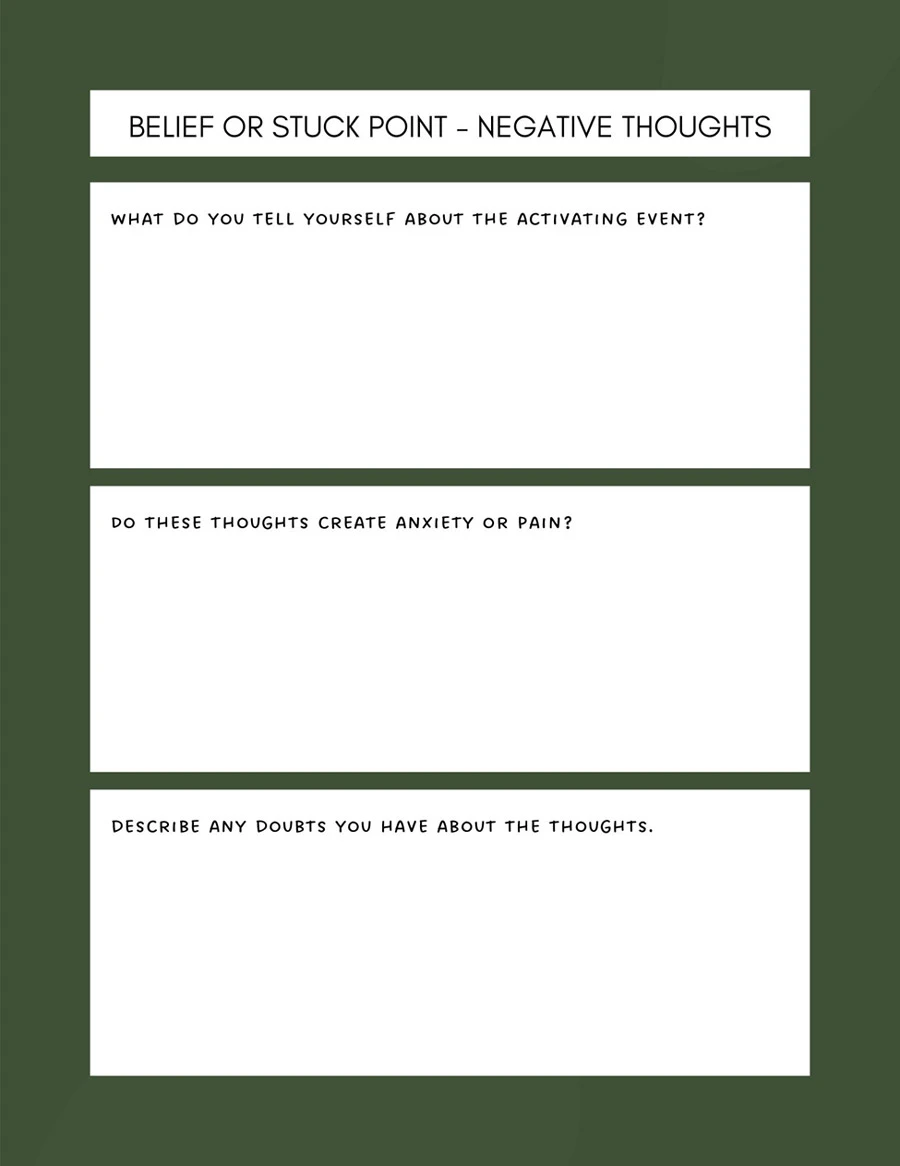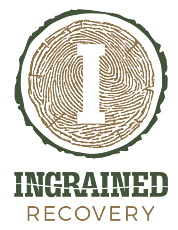Our Resources for Clinicians and for Clients Doing Trauma Work
Our Cognitive Processing Therapy worksheets provide an effective tool for emotional processing. These CPT worksheets encourage those struggling with PTSD to play an active role in shaping their trauma narratives.
This approach is necessary because as many as 60% of people in recovery relapse within their first year after treatment. This staggering statistic from the National Institute on Drug Abuse (NIDA) shows us the importance of giving people in recovery all the essential life skills and coping strategies needed.
Overcoming their mental health symptoms and processing traumatic experiences is only the first part of healing. They must next learn to rebuild their lives despite the experienced trauma.
Ingrained Recovery offers complete mental health services for our clients, from drug and alcohol recovery to post-traumatic stress disorder, or PTSD. We understand how some people survive traumatic events relatively unscathed while others struggle with unhealthy beliefs about the trauma for the rest of their lives. The latter needs a structured framework to manage recurring symptoms related to the trauma.
Please read more to see how our Cognitive Processing Therapy worksheets can help address trauma-related mental health concerns.
What is Cognitive Processing Therapy, and How Does it Help PTSD Symptoms?

Cognitive Processing Therapy (CPT) is similar to Cognitive Behavioral Therapy (CBT) but follows a different approach. Before we share the worksheets, let’s review the key principles of cognitive processing therapy sessions and their benefits.
- Education: Therapy sessions begin with the mental health provider helping the person experiencing trauma gain a better understanding of PTSD and how it can impact their daily lives.
- Trauma Narrative or Trauma Account: In the next session, the client writes about the traumatic event in great detail. Writing will help identify negative beliefs and find healthier alternative thoughts.
- Identifying Stuck Points: Identifying the repetitive thought patterns of denial, minimization, and other forms of harmful automatic thoughts that cause the traumatic event to play in the mind in nightmares and flashbacks over and over again.
- Challenging Unhelpful Beliefs: Clients will challenge unhelpful beliefs as the therapy continues. They will ask if their beliefs related to the trauma are true or untrue. These therapy sessions support cognitive restructuring or modifying untrue or maladaptive beliefs.
- Homework Assignments: The therapy process takes 12 weeks and features sessions of 60 to 90 minutes each. Practice assignments can help the healing journey by keeping concepts fresh between therapy days.
During CPT, clients continue other evidence-based treatment, including individual and group therapy sessions. By the final session of CPT, clients usually see a significant reduction in self-critical thinking and PTSD symptoms.
Confidential Trauma and PTSD Assessment
Find Help At Ingrained Recovery
Cognitive Processing Therapy Exercises for Post-Traumatic Stress Disorder
Cognitive processing therapy exercises are usually called ABC Worksheets. You might also hear counselors call these ABC worksheets. They might also call it a stuck point log, as you complete one sheet to work through every single stuck point until you challenge and dismantle them all in o
ABC worksheets help people connect their events, thoughts, and feelings of self-blame or shame and challenge them. The cognitive skills developed when completing a challenging belief worksheet offer many long-term benefits, mainly because the process applies to many areas of life.
In an often complementary resource, Ingrained also offers art therapy worksheets to help our clients, as well as clinicians across the country, support recovery success.
A – Activating Event

ABC worksheets start at the beginning, identifying the traumatic experiences that contributed to the mental health distress. The client defines the event in this section as precisely as possible. Details should include where clients were and who was with them during the activating event, the sequence of events, and any other details the counselors should know throughout the treatment.
For completing these journal pages, we’ll follow the example of ‘Rosie,’ who completes her CPT sessions with a professional therapist.
Here’s what Rosie’s Activating Event information might look like:
I was leaving the gym, happy because I had just earned a certificate of completion for finishing some intense weightlifting sessions. I was alone and had noticed the sun lowering in the warm summer sky. The evening cool felt good on my skin. While walking home to my apartment, I stayed aware of my surroundings. Despite paying attention, a tall but slender man wearing a full ski-type mask over his face pulled me into a dark alleyway.
I fought back, not wanting him to snatch my gym bag. It contained my ID, money, apartment keys, and expensive AirPods. He pulled a knife out and held it near my face. As I let go of the bag, he nicked my jawline with the knife. It left a small but permanent, visible scar. Other people tell me they do not notice but it feels very noticeable to me, and when I get mad or anxious it feels like it pulses and makes me even more so.
B- Beliefs Worksheet

The next section is the Beliefs Worksheet. It examines the negative automatic thoughts and beliefs about the trauma. Writing down the beliefs can help the patient see the untruth from a birds-eye view.
Let’s continue to follow Rosie as she gives us a better sense of her trauma:
Every day, I live with daily, prolonged exposure to the attack whenever I look in the mirror. I feel unlovable and unattractive. It has had the impact of making me feel ugly, inside and outside. Even when someone offers me compliments about my looks, I can’t believe their kind words. I deny every compliment.
I don’t know if I’ll ever feel comfortable in my own skin again and resent looking in the mirror to put on my makeup every day.
C- Consequences

The challenging beliefs worksheet also includes space for an impact statement, where the client can note how the activating event has played a role in their lives. This statement includes the associated feelings and actions taken in response.
Here’s what Rosie might say about the consequences of the armed robbery:
I’m angry at my attacker every day and still very upset that my face will never look quite the same again. I feel so violated. The man who robbed me got away without ever being caught, but I have to live with evidence of his attack every day. My family tries to support me but gets more frustrated every day that I can’t move past this trauma. Friends tell me I’m beautiful, and my makeup makes the scar invisible.
But no matter what they say, I still believe that they’re wrong. I have no evidence that they’re telling me lies when they say that they can’t see the scar. I guess that’s because I see it every time I pass by a mirror.
Sharing Stuck Points Worksheets With a Therapist
After completion of the Cognitive Processing Therapy (CPT) worksheets, the therapist guides them through cognitive restructuring. Clients start questioning and challenging the harmful beliefs. In the last weeks of PTSD treatment, the therapists help clients replace their negative thinking with positive adaptive beliefs.
In Rosie’s cognitive restructuring session, the counselor would guide her toward changing her attitude to increase self-esteem. For instance, she may guide Rosie to realize that the scar is barely visible and undetectable when she wears makeup. The therapist might even encourage Rosie to view the scar as a badge of survival instead of thinking of it as an imperfection.
Get Effective Trauma Treatment Options
Find Help At Ingrained Recovery
Does Cognitive Processing Therapy (CPT) Benefit Other Mental Health Disorders?
Yes. CPT can help improve depressive symptoms, anxiety disorders, and other trauma-related conditions. Similarly to using processing therapy for PTSD, using the technique has great effectiveness in supporting clients struggling with similar disorders.
That’s because these tools focus on changing negative, untrue thoughts and feelings often present in those disorders.
PTSD Reduces the Quality of Life in Many Clients

When clients don’t get treatment to resolve the negative impacts of PTSD, the trauma continues to build steam like a runaway freight train. The train starts slowly, and it builds steam to power the engine. Once it reaches full capacity, it’s difficult to slow it down and could potentially get out of control without expert handline.
Similarly, PTSD can cause the client experiencing trauma to have the following undesirable outcomes if they don’t receive CPT to cope with the symptoms:
Reduced Mental Health
PTSD can lead a patient to a dark place of depression, anxiety, or even considering self-harm or suicide. The stuck points can also lead them to emotional numbness or a sense of detachment. The consequences of this can be devastating to the patient and their loved ones. CPT treatment can help improve this situation and help the person develop healthier alternative thoughts.
Physical Health Decline
The stuck points of unresolved PTSD can contribute to physical stress, high blood pressure, ulcers, or other gastrointestinal diagnoses. Completion of CPT to treat the mental health aspects in this patient can support recovery from the physical health decline. In this case, the CPT therapist will often take an integrative approach, with the mental health provider working closely with other physicians.
Substance Abuse
Clients who don’t seek PTSD treatment use drugs or alcohol as inappropriate coping tools. They often choose alcohol or opioid drugs to dull the pain or sleep through it or stimulants to give their mood an artificial boost. Either way, it’s an ineffective short-term solution. The addiction leads to a steep decline in both the person’s mental and physical wellness.
Impacts on Relationships

Those with untreated PTSD symptoms often withdraw emotionally, leaving family, friends, and even colleagues perplexed by their new, cold behavior. They may snap at others quickly or develop difficulty trusting others. CPT can help this person start to analyze their thoughts and behavioral responses, session by session.
Employment Issues
Without CPT treatment for stuck points, people can develop issues with concentration and focus. With an impaired ability to perform completion of tasks correctly and on time, job loss can quickly become a reality. Depression, addiction, and shaken self-confidence make matters even more likely after losing a job.
Up To 100% of Rehab Covered By Insurance
Find Help At Ingrained Recovery
Get Evidence-Based Care for PTSD at Ingrained
If your PTSD symptoms hold you back from healing and feeling good about your best life, it’s time to get help. Without professional trauma treatment, your sense of well-being may continue to erode.
You can overcome your stuck points and have significant symptom reduction! The Ingrained Recovery team will develop a custom CPT treatment plan, helping clients work on their trauma and restoring a sense of self-efficacy.
Are you ready to start your CPT sessions to minimize your PTSD symptoms? Call us today!

